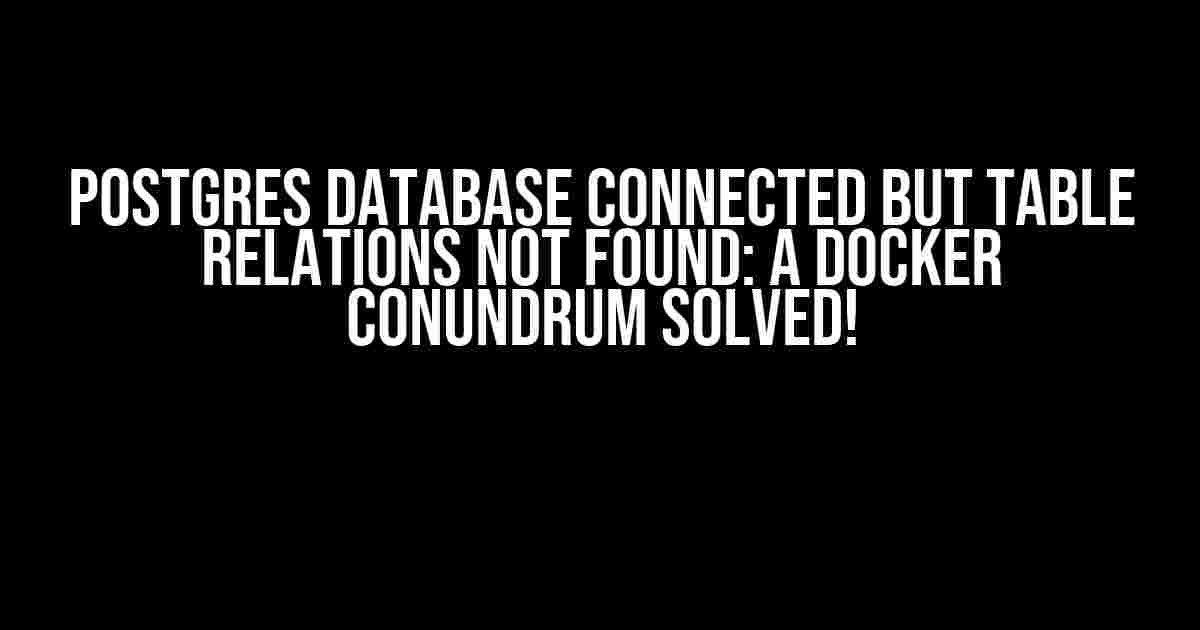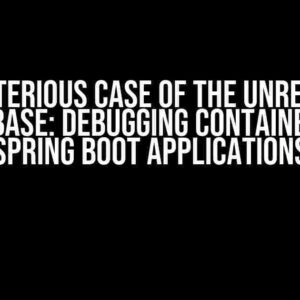Are you tired of staring at your terminal, wondering why your Node.js API can’t seem to find the table relations in your Postgres database, even though the connection is established? You’re not alone! In this article, we’ll dive into the world of Docker containers and uncover the secrets to resolving this frustrating issue.
The Symptom: Database Connection Established, but Table Relations Nowhere to be Found
Let’s set the scene: you’ve successfully connected your Node.js API to a Postgres database within a Docker container. You can clearly see the database being listed in your Docker compose file, and you’ve even gone so far as to seed the database with sample data. But, when you try to query the database or perform CRUD operations, you’re met with a puzzling error message:
Error: Table relations not found
The error message is maddeningly vague, leaving you wondering what could possibly be causing this issue. Fear not, dear reader, for we’re about to embark on a journey to uncover the root cause and provide a clear solution to this vexing problem.
Understanding Docker Volumes and Database Persistence
Before we dive into the solution, it’s essential to understand how Docker volumes work and how they impact database persistence. When you spin up a Docker container, it’s ephemeral by nature – meaning that any data written to the container is lost when it’s terminated or restarted. To overcome this limitation, Docker provides a mechanism called volumes, which allow you to persist data even after the container is gone.
In the context of a Postgres database, this means that you need to configure a volume to persist the database data. When you do this, Docker creates a directory on the host machine that maps to a directory within the container. This allows your database data to be preserved even when the container is restarted or deleted.
Docker Compose File and Volume Configuration
Let’s take a look at a sample Docker compose file that demonstrates how to configure a volume for a Postgres database:
version: '3'
services:
db:
image: postgres
environment:
POSTGRES_USER: myuser
POSTGRES_PASSWORD: mypassword
POSTGRES_DB: mydb
volumes:
- ./pgdata:/var/lib/postgresql/data
ports:
- "5432:5432"
In this example, the `volumes` keyword is used to specify a directory on the host machine (./pgdata) that maps to a directory within the container (/var/lib/postgresql/data). This allows the database data to be persisted even when the container is restarted or deleted.
The Culprit: Database Initialization and Schema Creation
Now that we’ve covered Docker volumes and database persistence, it’s time to explore the root cause of the issue. The problem lies in the way you’re initializing and creating the database schema. When you spin up a new Postgres container, the database is created with an empty schema. This means that the table relations, which are essential for querying and performing CRUD operations, are not present.
To resolve this issue, you need to create the database schema programmatically within your Node.js API. This can be achieved using a library like Sequelize, which provides an intuitive way to interact with your Postgres database.
Sequelize and Database Schema Creation
Here’s an example of how you can use Sequelize to create a database schema programmatically:
import { Sequelize } from 'sequelize';
const sequelize = new Sequelize('mydb', 'myuser', 'mypassword', {
host: 'localhost',
dialect: 'postgres',
});
sequelize.authenticate().then(() => {
console.log('Database connected');
// Create the database schema
const User = sequelize.define('User', {
id: {
type: Sequelize.INTEGER,
primaryKey: true,
autoIncrement: true,
},
name: {
type: Sequelize.STRING,
},
});
const Product = sequelize.define('Product', {
id: {
type: Sequelize.INTEGER,
primaryKey: true,
autoIncrement: true,
},
name: {
type: Sequelize.STRING,
},
price: {
type: Sequelize.FLOAT,
},
});
// Create the table relations
User.hasMany(Product, {
foreignKey: 'userId',
onDelete: 'CASCADE',
});
Product.belongsTo(User, {
foreignKey: 'userId',
});
// Sync the database schema
sequelize.sync({ force: true }).then(() => {
console.log('Database schema created');
});
});
In this example, Sequelize is used to create a database schema with two tables: `User` and `Product`. The `hasMany` and `belongsTo` methods are used to establish the table relations, which are essential for querying and performing CRUD operations. Finally, the `sync` method is used to create the database schema programmatically.
Putting it All Together: Docker, Node.js, and Postgres
Now that we’ve covered the key components, let’s put everything together. Here’s an example of a Docker compose file that integrates a Node.js API with a Postgres database:
version: '3'
services:
app:
build: .
environment:
DATABASE_URL: postgres://myuser:mypassword@db:5432/mydb
depends_on:
- db
ports:
- "3000:3000"
db:
image: postgres
environment:
POSTGRES_USER: myuser
POSTGRES_PASSWORD: mypassword
POSTGRES_DB: mydb
volumes:
- ./pgdata:/var/lib/postgresql/data
ports:
- "5432:5432"
In this example, the Docker compose file defines two services: `app` and `db`. The `app` service is built from the current directory (using the `.` notation) and is dependent on the `db` service. The `DATABASE_URL` environment variable is used to configure the connection to the Postgres database.
The `db` service uses the official Postgres image and configures the database with environment variables. The `volumes` keyword is used to persist the database data to a directory on the host machine (./pgdata).
Conclusion
In this article, we’ve explored the mystifying issue of a Postgres database being connected but table relations not being found when running a Node.js API in a Docker container. By understanding Docker volumes and database persistence, we’ve uncovered the root cause of the problem: database initialization and schema creation. By using a library like Sequelize, we’ve demonstrated how to create the database schema programmatically and establish table relations.
By putting everything together, we’ve created a Docker compose file that integrates a Node.js API with a Postgres database, ensuring that the database data is persisted even when the container is restarted or deleted.
If you’re still struggling with this issue, I encourage you to try out the solutions presented in this article. Remember to carefully configure your Docker compose file, create the database schema programmatically, and establish the table relations using Sequelize. With persistence and patience, you’ll be querying your Postgres database in no time!
Additional Resources
For further reading and exploration, I recommend checking out the following resources:
| Keyword | Explanation |
|---|---|
| Postgres database | A popular open-source relational database management system. |
| Node.js API | A JavaScript runtime built on Chrome’s V8 JavaScript engine, ideal for building server-side applications. |
| Docker container | A lightweight and portable way to deploy applications, providing isolation and reproducibility. |
| Table relations | The relationships between tables in a database, essential for querying and performing CRUD operations. |
Last but not least, I’d like to thank you for reading this article. If you have any questions or comments, please don’t hesitate to reach out. Happy coding!
Frequently Asked Question
Get answers to the most pressing questions about Postgres database connections and table relations in Node.js TypeScript API running in a Docker container!
Why can’t I find table relations in my Postgres database when running my Node.js TypeScript API in a Docker container?
This could be due to the fact that your Docker container’s network settings are not properly configured. Make sure your Docker container is running on the same network as your Postgres database. You can do this by adding a `–net` flag when running your Docker container, like this: `docker run –net=host my-image`. This will allow your container to access the host machine’s network, including your Postgres database.
I’ve checked my network settings, but I’m still getting an error. What else could be the issue?
Another possible reason is that your TypeORM configuration is not set up correctly. Make sure you have the correct `host`, `port`, `username`, and `password` settings in your `typeorm.config.js` file. Also, ensure that your Postgres database is listening on the correct port and that the username and password are correct.
I’ve double-checked my TypeORM configuration, but I’m still getting an error. What’s next?
It’s possible that your Postgres database schema is not being created correctly. Try adding the `synchronize` option to your TypeORM configuration and set it to `true`. This will force TypeORM to create the database schema when the application starts. Also, make sure you have the correct `entities` and `migrations` settings in your TypeORM configuration.
What if I’m using a Docker Compose file to manage my containers?
If you’re using a Docker Compose file, make sure you’ve defined the correct `networks` configuration for your containers. You can do this by adding a `networks` section to your Docker Compose file, like this: `version: ‘3’; services: app: … ; networks: default: external: name: my-network`. This will allow your containers to communicate with each other on the same network.
Is there anything else I can do to troubleshoot the issue?
Yes! You can try checking the Postgres database logs to see if there are any error messages related to the connection or table relations. You can also try using a tool like `pgAdmin` to inspect the database schema and verify that the tables and relations are being created correctly. Additionally, you can enable debug logging in your TypeORM configuration to get more detailed error messages.




